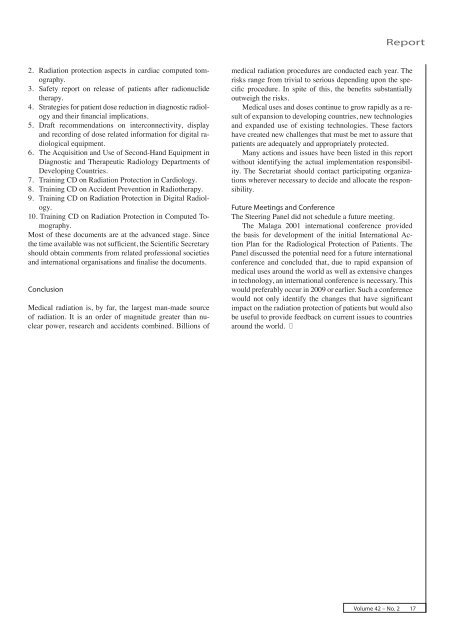ISRRT_August_2006
Create successful ePaper yourself
Turn your PDF publications into a flip-book with our unique Google optimized e-Paper software.
Report<br />
2. Radiation protection aspects in cardiac computed tomography.<br />
3. Safety report on release of patients after radionuclide<br />
therapy.<br />
4. Strategies for patient dose reduction in diagnostic radiology<br />
and their financial implications.<br />
5. Draft recommendations on interconnectivity, display<br />
and recording of dose related information for digital radiological<br />
equipment.<br />
6. The Acquisition and Use of Second-Hand Equipment in<br />
Diagnostic and Therapeutic Radiology Departments of<br />
Developing Countries.<br />
7. Training CD on Radiation Protection in Cardiology.<br />
8. Training CD on Accident Prevention in Radiotherapy.<br />
9. Training CD on Radiation Protection in Digital Radiology.<br />
10. Training CD on Radiation Protection in Computed Tomography.<br />
Most of these documents are at the advanced stage. Since<br />
the time available was not sufficient, the Scientific Secretary<br />
should obtain comments from related professional societies<br />
and international organisations and finalise the documents.<br />
Conclusion<br />
Medical radiation is, by far, the largest man-made source<br />
of radiation. It is an order of magnitude greater than nuclear<br />
power, research and accidents combined. Billions of<br />
medical radiation procedures are conducted each year. The<br />
risks range from trivial to serious depending upon the specific<br />
procedure. In spite of this, the benefits substantially<br />
outweigh the risks.<br />
Medical uses and doses continue to grow rapidly as a result<br />
of expansion to developing countries, new technologies<br />
and expanded use of existing technologies. These factors<br />
have created new challenges that must be met to assure that<br />
patients are adequately and appropriately protected.<br />
Many actions and issues have been listed in this report<br />
without identifying the actual implementation responsibility.<br />
The Secretariat should contact participating organizations<br />
wherever necessary to decide and allocate the responsibility.<br />
Future Meetings and Conference<br />
The Steering Panel did not schedule a future meeting.<br />
The Malaga 2001 international conference provided<br />
the basis for development of the initial International Action<br />
Plan for the Radiological Protection of Patients. The<br />
Panel discussed the potential need for a future international<br />
conference and concluded that, due to rapid expansion of<br />
medical uses around the world as well as extensive changes<br />
in technology, an international conference is necessary. This<br />
would preferably occur in 2009 or earlier. Such a conference<br />
would not only identify the changes that have significant<br />
impact on the radiation protection of patients but would also<br />
be useful to provide feedback on current issues to countries<br />
around the world. <br />
Volume 42 – No. 2 17


















